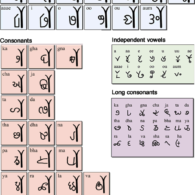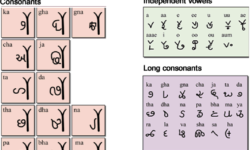Profile
Parji is one of nearly twenty scripts created by Dr. Prasanna Sree for indigenous and minority groups, mostly in Andhra Pradesh. In each case, the design of the script reflects some iconic feature of the culture of that linguistic community. She writes:Parji is a variety of Odia language spoken in Odisha in India. The term Porja seems to have been derived from Odia words po and raja which mean “son of a king.” The language is also known as Gorum, GorumSama, ParangiPorga, ParangiPorja, Pareng, Parenga, ParengaParja, Parengi, Parenji, and Poroja.
The terms Porja and Parja seem to be synonymous. Parji language is identical with Bhatri which has now become a form of Odia. Most of them have migrated from Orissa State about 300 years back to the present habitat in search of cultivable land.
The Porja are a hill tribe inhabiting the Agency Area of Visakhapatnam District, and in adjoining areas of Odisha State. They are chiefly shifting agriculturists and cultivate lands on the high-level hill slopes. A numerically small tribe with a population of 12,600 as per the 2001 census, they reside mainly in the Munchangiputtu, Ananthagiri and PeddaBayaluMandals.
The Porja are mostly illiterate, and children are not encouraged by their parents to attend schools because they are seen as an additional source of family income.
The Porja script is based on their seasonal or semi-nomadic agricultural practices. Traditionally, they farm an area for eight months to two years, but before they move on, they scatter seeds as a final ritual of thanks to Nature. They believe the seeds, and the resulting shoots, will attract the souls of the hungry, who will be able to feed on the crops the Porja have left behind. The common design element, then, is a young shoot, growing from a seed the Porja sowed before they left.
You can help support our research, education and advocacy work. Please consider making a donation today.


